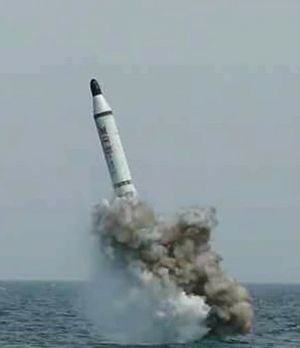Kim Jong-un couldn’t head to Moscow to celebrate Russia’s Second World War Victory Day so he settled for the next best thing: overseeing the first-ever test-firing of a North Korean submarine-launched ballistic missile (SLBM). The regime’s mouthpiece, Korean Central News Agency (KCNA), noted that Kim watched as North Korea’s Bukkeukseong-1 (“Polaris-1”) SLBM “soared to the skies.”
The physical design of the missile, as seen in a few clear images released by KCNA, resembles the Soviet Union’s R-27/SS-N-6 Serb SLBMs, which suggest a single-stage, storable liquid-propellant design. KCNA’s images, upon preliminary analysis, appear to be authentic and presented without any manipulation.
Neither KCNA nor any secondary sources have verified the location of the missile launch. KCNA noted that the launch was carried out far away from the land. In images shared by the agency, Kim Jong-un is seen observing the launch from the deck of a boat. South Korea’s Yonhap News Agency suggests that the launch likely took place on Friday off North Korea’s Sinpo South Shipyard, a facility on the country’s eastern coast. (Based on satellite imagery analysis, Sinpo was strongly believed to be the site of North Korea’s ongoing SLBM research and development.)
The test marks a significant milestone in North Korea’s bid to modernize and develop its offensive capabilities, demonstrating the regime’s sharp progress toward a difficult-to-detect naval strike capability. According to Yonhap, if North Korea can operationalize its SLBMs to be reliable and precise, it will be “at least a decade ahead of the South.” South Korea’s navy plans to deploy SLBMs by 2030, on six 3,000-ton submarines.
Crucially, if North Korea manages to combine its SLBMs with a nuclear device, it could field a sea-based nuclear deterrent. Based on what is known now about North Korea’s nuclear weapons program, Pyongyang has successfully miniaturized some nuclear devices.
For the moment, South Korean officials are reading Friday’s test as one focused primarily on SLBM ejection. An ejection test would suggest that the missile’s efficacy at range and precision were not the primary focus of the test. Instead, the North Korean military was likely more interested in the Polaris-1’s ability to successfully clear the surface of the water with adequate thrust. South Korean officials estimate that the missile flew for just 100 meters above the surface.
The Bukkeukseong-1 confirms earlier reports by U.S. officials, including U.S. Strategic Command’s Admiral Cecil D. Haney, that North Korea was making concrete progress toward its first SLBM. Late last year, General Curtis Scaparrotti, the commander of U.S. Forces Korea, noted that he believed that North Korea had “the technology to potentially actually deliver what they say they have.” Friday’s test lends credence to both these assertions.

































